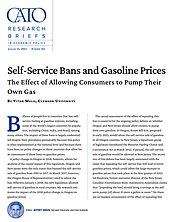A policy change in Oregon in 2018, however, allows for analysis of the causal impact of this regulation. Oregon and New Jersey were the only states that banned the self-service sale of gasoline from 1992 to 2017. In March 2017, however, the Oregon House of Representatives voted to adjust the ban. Effective January 1, 2018, the new legislation allowed self-service of gasoline in rural counties. My research estimates the impact of the 2018 policy change in Oregon on gasoline prices.
The causal assessment of the effect of repealing this ban is essential for the ongoing policy debate on whether Oregon and New Jersey should allow citizens to pump their own gasoline. In Oregon, House Bill 4151, proposed in early 2022, would allow the self-service sale of gasoline in all Oregon counties. In New Jersey, a bipartisan group of legislators introduced the Motorist Fueling Choice and Convenience Act in March 2022. If passed, the self-service sale of gasoline would be allowed in New Jersey. The recent rise of this debate has been largely associated with the claim that repealing the self-service ban will lead to lower gasoline prices, which could offset the large increase in gasoline prices that took place in the first quarter of 2022. Sal Risalvato, former executive director of the New Jersey Gasoline—Convenience Store—Automotive Association claims that “[repealing the ban] should bring a savings at the self-serve pump [of] about 15 cents a gallon or more.” Yet there are no modern assessments of the effect of repealing this ban on gasoline prices. My research fills this gap and contributes to the understanding of a policy that affects millions of consumers in the United States and billions of consumers throughout the world.
Gasoline stations in counties that ban the self-service sale of gasoline can only serve gasoline to their customers by hiring employees to perform the task. This restriction is expected to increase the cost for gasoline stations. The magnitude of this increase in cost will depend on labor costs as well as on other characteristics of gasoline stations, such as the frequency of sales or the number of pumps, among others. The increase in costs associated with the gasoline self-service ban leads to a reduction in supply and a subsequent increase in gasoline prices.
My research uses high-frequency gasoline price data to estimate the effect of repealing this regulation on prices. I apply statistical methods to compare changes in gasoline prices in Oregon counties that allow self-service (which have a population below 40,000) with those counties that do not (which have a population above 40,000) before and after the policy repeal. I use daily unleaded gasoline price data reported to the mobile application GasBuddy for individual stations in the state of Oregon from January 1, 2016, to December 31, 2019. My results reveal a sizable impact of repealing the self-service gasoline ban on gasoline prices: the price of gas falls by 4.4 cents per gallon on average.
The U.S. Energy Information Administration reports that U.S. drivers consumed an average of 656 gallons of gasoline in 2015. Since the counties affected by this repeal were rural, the average consumption of affected drivers may be larger than for the average American. But if the average gasoline consumption in rural Oregon counties is similar to the national average, my estimated price reduction of 4.4 cents per gallon represents approximately $90 in expected annual savings for a household with three licensed drivers.
These results cannot be directly extrapolated to countries that currently ban the self-service sale of gasoline, since other nations have different labor and gasoline market structures. Yet the direction of this effect should be the same in other states and countries and should be proportional to the difference in gasoline station costs. According to the Quarterly Census of Employment and Wages, labor costs of rural counties in Oregon are lower than those of urban counties in Oregon and New Jersey. Thus the reduction in labor costs associated with repealing this regulation in urban Oregon counties and New Jersey is likely to be larger, which implies that repealing this ban in urban counties in Oregon and New Jersey is likely to reduce prices by more than 4.4 cents per gallon. These findings are essential for the debate over whether to repeal this ban in states as well as in other countries with the same restriction.
Note
This research brief is based on Vitor Melo, “Self-Service Bans and Gasoline Prices: The Effect of Allowing Consumers to Pump Their Own Gas,” Social Science Research Network, April 2022.

